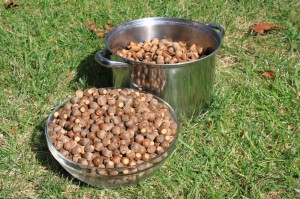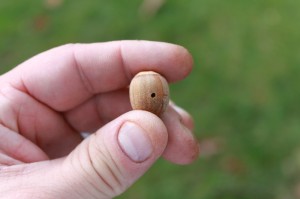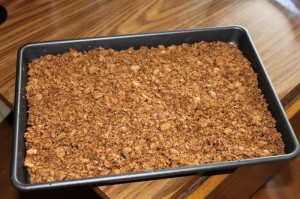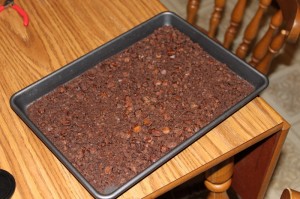Making Acorn Flour and Muffins
by Steve Struebing on Dec.14, 2009, under technoPHOBE

Acorns from my Oak out front
I am trying to recall the exact moment when I set my mind to making food from acorns. It could have been any of the following moments:
a) When reading “When Technology Fails” I wanted to take a stab at more self-sufficiency
b) When I listened to “Everybody Dance Now” I was inspired by “I’m just a squirrel tryin’ to get a nut”
c) When I moved to into my new house this summer, I saw the MASSIVE oak out front and knew the acorns were coming

Oak tree - the acorn donor

Oak leaf
Whatever planted the seed, it was obvious that I needed to make acorn flour. Apparently, acorn flour was a food that was made by native peoples (I have since confirmed reading some blogs of families of Native American descent who used to hoard massive amounts of acorns for making food).
The first step was harvesting the acorns. At the beginning it was not terribly easy as I stalked the yard (to the bewilderment of my new neighbors who must have thought me out of my mind… or rather, having “gone nuts”) looking for an acorn that had not fallen far from the tree. It became increasingly easy as the season wore on and by the end of fall, I was kicking myself for trying so hard at the beginning of fall where by the end I could, and did, rake bags full of the stuff. Ah well, you live you learn.

Acorns lying in the front yard

Not just for squirrels anymore
After having gathered what I considered a reasonable amount, the next step was removing the acorn top cupule. No, I did not know that word before I looked it up. Feel free to use it in scrabble for 10 points. That was easy enough for the “early season” acorns, and virtually did the job by itself for the late season ones.
Next was going through the stash and finding any acorns that showed evidence of rot, or worms.

Damaged acorn

Telltale sign of worm presence
Next, and certainly the most fun (please note sarcasm) part of the process was shelling. I tried just using my hands, then a few with teeth, and finally settled on a set of adjustable pliers the perfect width to apply enough pressure just to crack the shell when closed. It was a slow and tedious process of cracking and peeling the somtimes stubborn shell from the nutmeat. Many a football Sunday was spent watching a game and shelling acorns. Yeah its weird, but damnit I was determined. When it was all said an done, the shelled acorns gave off a sweet, nutty, almost bourbon scent.

Unshelled, shelled, and acorn shells
So before you just run off and throw a handfull of shelled acorns into your mouth and consider yourself educated, there is something you should know about acorns. Apparently they are very high in tannic acid. This is not good for your system (I have read somewhere that even animals may wait for rains to rinse the tannins). Take a small nibble of an acorn and you will feel that rough acidic bitterness that will turn you off from said handfull. The proces of removing this water-soluble acid from the nutmeat is called leaching. I effectively chopped the acorns into smaller bits to increase the surface area and allowed the water to do its work.
The water browned significantly the first morning, so I changed the water. Then the first night, so I changed the water. Then day 2 morning and night so I changed the water. Then day 3…then day 4… you get the point. 2 water changes for over 2 1/2 weeks. After that time, I tasted the acorn and there was very little residual acidicy, so it was onto the drying phase. I have read its possible to to leach by putting a pillowcase of acorns in stream for a while to do this, or in extreme cases, put them in the upper tank (I repeat, UPPER TANK) of a toilet because the water is clean and changes regularly. I didn’t do this.

Water browned from tannis being leached out
The nutmeat was spread evenly onto a baking pan and I forced my wife to make pizza so I could use the “leftover” heat to dry the acorns. I think they were left in for too long as is evidenced through significany browning. They were almost a coffee roast, but smelled good.

Wet acorn nutmeat before drying

Oven-dried (and roasted) acorns
Ever the purist, I went the motar and pestle route to mill them. (Footnote: This inspired me to read about millstones, which are more fascinating than you think. Take a quick read about the patterns millstones cut with and how they are dressed. I thought they just pulverized, which they do not). After a laborious while, I had made a small bit of flour. Losing steam, I went to my coffee burr grinder and made quick work of the rest, grinding into a fine flour.

Milling the hard way - Mortar and Pestle

After milling the easy, and non-purist, way. Boo technoPhiles!
The last step was to make something edible. The flour tasted fine by itself. Somewhat bland
but with a nice nutty finish. My wife was kind enough to look up a “Traditional Acorn Flour” recipe for Acorn Muffins.
They turned out very dark and after a first taste they were…shall we say….harsh. It didn’t matter and I stubbornly gagged down the muffin, grinning in my self-sufficiency. The recipe did not call for butter nor sugar. I quickly topped them with sugar and ate one with butter. It was much better that way.

Sugar-topped acorn muffin
Nutrition Facts (from http://www.elook.org/nutrition/nuts/3218.html)
Serving Size: (100 grams)
Amount Per Serving
Calories: 501
% Daily Value*
Total Fat 30g 46%
Saturated Fat 4g 19%
Cholesterol 0mg 0%
Sodium 0mg 0%
Total Carboydrates 55g 18%
Dietary Fiber 0g ~
Sugars 0g ~
Protein 7g 14%
Vitamin A 1% Vitamin C 0%
Iron 6% Calcium 4%
So, my technoPhobe friends, this was a fine day. I have never really been a gardener or worked on a farm. I like most Americans get my food from the store. This was about finding a small amount of nutrition raining down in my front yard. It was more time and effort than I was expecting, but its encouraging to think that if I had to, I could survive a couple days by spending a bit of time under an oak. All the better if its mine…


December 16th, 2009 on 9:48 am
And here I thought acorns were only good for acorn fights. I’m surprised the fiber is so low.
December 16th, 2009 on 3:52 pm
Or you could go to a store selling Korean food and buy acorn flour and acorn starch in a plastic bag.
December 16th, 2009 on 4:13 pm
Jim, thanks for the execellent links on nativerecipes.com. I will certainly have to take a good look there. Of course it would be easier to buy the flour, but I this was more an exercise in DIY. Perhaps for the next go at acorn dishes I will do so. Thanks!
March 6th, 2010 on 10:11 pm
Hello Steve, thanks for your detailed description regarding harvesting and utilising acorns. I too have a lovely oak tree in the front garden. The oak tree has been a symbolic tree for my family. I now have my beloved pet pig buried under my oak tree so it means even more to me know. We harvested lots of acorns yesterday. Our oak tree is a white oak so it shouldn’t have too much tannin. The town where i live is packed with majestic oak trees. So very beautiful. Once again thanks for your effort…..kind regards, Margaret (Gisborne, Australia)
March 8th, 2010 on 9:13 am
Margaret,
Wonderful to hear from you. I would suggest adding some brown sugar or honey to the recipe to offset some residual bitterness. Or perhaps your patience in rinsing out whatever tannins exist in your White Oak exceeds mine! Either way, best of luck and let me know how it goes. It is a good way to feel a little more connected to where we get our nourishment. Thank you kindly for stopping by the site.
May 15th, 2011 on 10:19 am
[…] have since moved to Virginia, and my new lawn has more than its fair share of wild garlic (and acorns). Rather than fight it, I figured I would embrace it and use it for a nice garlic […]